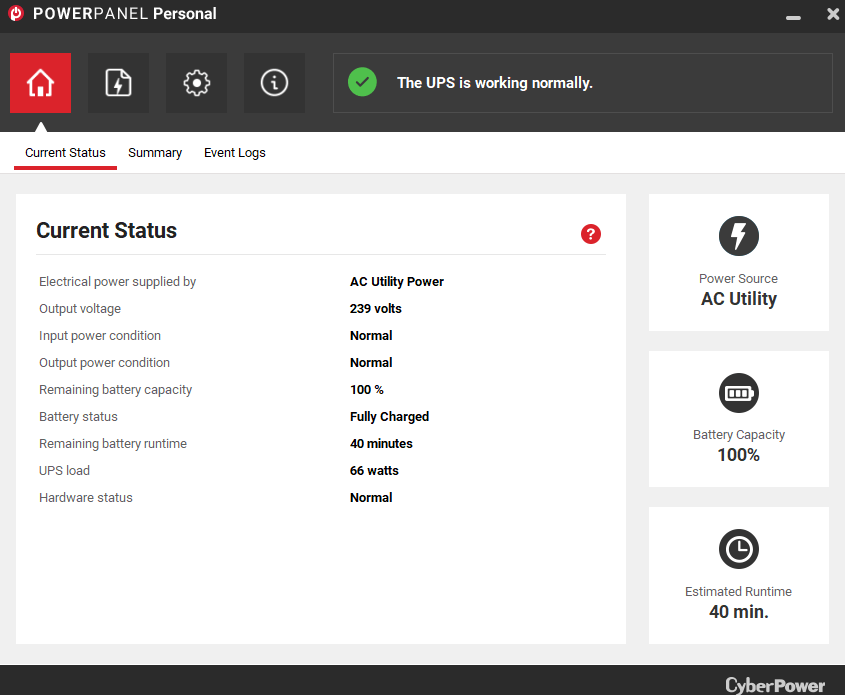CyberPower UPS software sets the stage for this enthralling narrative, offering readers a glimpse into a story that is rich in detail with formal and friendly language style and brimming with originality from the outset.
CyberPower UPS software plays a crucial role in managing uninterruptible power supply systems efficiently, providing users with essential functions and benefits for seamless operations.
Overview of CyberPower UPS Software
CyberPower UPS software is a vital tool designed to manage uninterruptible power supply systems efficiently. It provides users with the ability to monitor, control, and configure their UPS devices, ensuring continuous and reliable power backup in case of outages or fluctuations.
Key Features and Benefits
- Remote Monitoring: Users can remotely monitor the status of their UPS devices, including battery levels, load capacity, and power input/output.
- Automatic Shutdown: The software enables automatic shutdown of connected devices during power outages to prevent data loss or damage.
- Customizable Alerts: Users can set up alerts to be notified of any issues or events related to the UPS system, ensuring timely action.
- Load Management: CyberPower UPS software allows for load shedding and prioritization to optimize power distribution during emergencies.
- Event Logging: Detailed event logs provide a record of UPS performance and power events for analysis and troubleshooting.
Installation and Setup Process
When installing CyberPower UPS software on your computer, it is essential to follow a step-by-step guide to ensure proper installation and configuration for optimal performance.
Step-by-Step Installation Guide, Cyberpower ups software
- Download the CyberPower UPS software from the official website.
- Run the installation file and follow the on-screen instructions to install the software on your computer.
- Once the installation is complete, launch the software to begin the setup process.
Configuration Options
During the setup process, you will encounter various configuration options that allow you to customize the software according to your needs. Some of the key configuration options include:
- Setting up automatic shutdown schedules for your devices in case of power outages.
- Configuring notifications to alert you of power events or battery status.
- Adjusting power management settings to optimize battery usage and performance.
Tips for Optimizing Settings
To enhance the performance of your CyberPower UPS software, consider the following tips:
- Regularly update the software to ensure you have the latest features and security patches.
- Calibrate the UPS battery periodically to maintain its efficiency and accuracy.
- Monitor power usage and adjust settings accordingly to maximize battery life.
Monitoring and Control Capabilities

Monitoring and controlling your UPS system is crucial for ensuring the safety and stability of your devices and data. CyberPower UPS software offers a range of features to help users effectively monitor and control their UPS systems through an intuitive interface.
Monitoring Features
- Real-time status updates: The software provides real-time information on the status of the UPS system, including input/output voltage, battery capacity, load levels, and runtime remaining.
- Event logging: Users can view a detailed log of past events and system activity, allowing for better troubleshooting and analysis.
- Graphical representations: Visual representations of data such as voltage fluctuations and load levels help users easily understand the performance of their UPS system.
Control Capabilities
- Remote shutdown: Users can remotely shut down their devices connected to the UPS system in case of power outages or emergencies.
- Load shedding: The software allows users to prioritize critical devices and shed non-essential loads to maximize runtime during power outages.
- Configuration settings: Users can customize settings such as voltage sensitivity, battery management, and shutdown parameters according to their specific requirements.
Alerts and Notifications
- Customizable alerts: Users can set up custom alerts for events such as power failures, battery low warnings, or system errors to stay informed in real-time.
- Notification options: The software can send alerts via email, SMS, or SNMP traps, ensuring that users are promptly notified of any critical issues.
- Proactive management: By receiving alerts and notifications, users can take proactive measures to address potential problems and prevent downtime or data loss.
Compatibility and Integration: Cyberpower Ups Software
When it comes to CyberPower UPS software, compatibility with various operating systems and hardware is crucial for seamless functionality and integration with other systems. Here are some key points to consider:
Compatible Operating Systems and Hardware
- CyberPower UPS software is compatible with popular operating systems such as Windows, Linux, and macOS, ensuring flexibility for different users.
- It also supports a wide range of hardware devices, including CyberPower UPS units and other third-party devices, providing versatility in system integration.
Integration Options with Other Software or Systems
- CyberPower UPS software offers integration options with network management systems (NMS) and other monitoring tools, enabling centralized control and monitoring of UPS devices.
- It can be integrated with virtualization platforms like VMware and Hyper-V for enhanced virtual environment management and UPS monitoring.
Examples of Integration for a Seamless Experience
- By integrating CyberPower UPS software with a network management system, users can receive real-time alerts and notifications about power events and UPS status, ensuring proactive maintenance and response.
- Integration with virtualization platforms allows for graceful shutdown of virtual machines in the event of a power outage, safeguarding critical data and applications.
Troubleshooting and Support

When using CyberPower UPS software, users may encounter various issues that can disrupt the functionality of the software. Here are some common problems and troubleshooting steps to resolve them:
Common Issues and Troubleshooting Steps
- Issue: Software not detecting UPS device.
- Troubleshooting: Check the USB or network connection between the UPS device and the computer. Ensure that the device is properly connected and powered on.
- Issue: Software not displaying accurate battery status.
- Troubleshooting: Calibrate the UPS device by performing a battery test through the software. If the issue persists, consider replacing the battery.
- Issue: Software crashing or freezing during operation.
- Troubleshooting: Update the software to the latest version available. Check for any conflicting programs running in the background that may be causing the software to malfunction.
- Issue: Error messages appearing when using the software.
- Troubleshooting: Note down the error message and search for solutions on the official CyberPower website or contact technical support for assistance.
Support Channels
If users encounter persistent issues with the CyberPower UPS software, they can seek assistance through the following support channels:
- Official CyberPower website: Users can access FAQs, troubleshooting guides, and software updates on the official website.
- Technical Support: Users can contact CyberPower’s technical support team via phone or email for personalized assistance with software-related problems.
- Community Forums: Joining online forums or discussion groups related to CyberPower products can provide users with insights and solutions from other users facing similar issues.
Final Thoughts

In conclusion, CyberPower UPS software emerges as a powerful tool for optimizing power supply management, offering a range of features that enhance monitoring, control, and troubleshooting capabilities for a reliable user experience.
